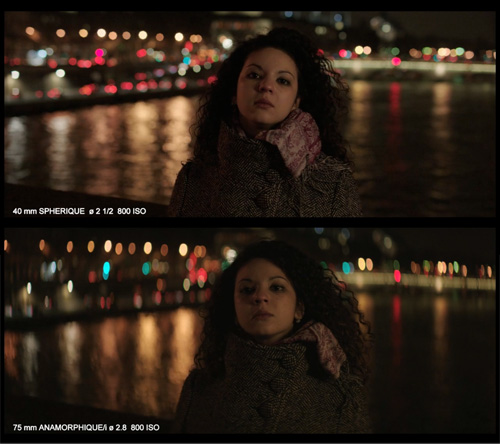A lot of aspiring filmmakers are all about getting anamorphic lenses. I have watched a lot of footage on them but I don't really see much of a difference between the image compared to regular DSLR lenses. Am I missing something? A lot of videos do not show a direct comparison though. I have to watch the picture, and then try to imagine what it would look like with regular DSLR lenses, and I am not seeing anything unique that I can spot, really.
"Imagining" a lens comparison!? A quick Google image search for "anamorphic lens test" found me this:

(Click to embiggen.)
In order to get widescreen, I have been shooting in regular 16:9, and then cropping the footage down to 2.40:1., so far. However, I was told that doing it this way is wrong, because when you do it that way, you do not have 1920 x 1080 pixels in your image, since the top and bottom quarters are being cropped off... cause you loose some of those pixels of course.
Yes, you will lose resolution if you crop to an aspect ratio that doesn't make use of the whole sensor. That isn't necessarily a bad thing, especially if the different aspect ratio better conveys the story and mood you are trying to sell. Plot before pixels.
I was told that with anamorphic, it will shoot at 1920 x1080, and then by squishing the image, you can squish it down to 2:40:1 around, and still have all 1920 x 1080 pixels, full HD, in your squished images, rather than cropping pixels off. Is this true? Is anamorphic really worth it for this alone, and it makes that much of an impression with people when they judge your demo reels and short films?
This is largely true, yes. However, you will most likely end up with your desqueezed footage letterboxed inside a 1920*1080 frame - there may or may not be an appreciable increase in sharpness.
Is it worth it for that alone? No, probably not. Any theoretical increase in resolution is likely to be negated by the softness of a lot of old anamorphic glass (i.e. the stuff you'd be able to afford to buy) and the high compression and low effective resolution of most DSLRs.
Do you want people to hire you just because of the kit you own or because they like your work and enjoy working with you?
It seems that this and getting good bokeh, but it seems the bokeh that comes with DSLR prime lenses is fine, and pretty good. Does anamorphic make all the difference? Or is their another reason why anamorphic is so popular that I am missing?
Look at the image above and decide for yourself. Lens choice and filtration is largely a matter of taste.
I regularly work with one DoP who often chooses SuperSpeeds with a polariser to introduce some contrast; another tends to go for sharper modern lenses then adds Black Pro-Mist filters to reduce contrast and introduce highlight flares.
Both approaches are equally valid and while they may produce not dissimilar results these subtle differences do add up.
Also even if you wanted better looking flares, wouldn't a star filter get you pretty good ones instead of buying anamorphic? Also wasn't Ben Hur shot with anamorphic lenses, cause that movie has a lot of deeper depth of field shots, so how did they do it, if it causes shallower DOF?
A star filter does not flare like an anamorphic lens, but you can get filters which do such as the
Optefex blue streak filters.
Which Ben Hur? The 1959 version was shot on 65mm; the 1925 film was shot in black and white and two-strip technicolor, the first experiments with anamorphic for cinema didn't occur til a few years later as far as I'm aware.
Want more depth of field? Add more light!
Okay thanks. If I am completely satisfied with my regular lenses, and the star filter, is it still worth getting anamorphic to impress other people though to hopefully get gigs? I mean will people love your movie more if it's full 1920 x1080 squished down compared to pixels cropped off?
No. And no.
Now he says that one of the major issues with shooting anamorphic on a DSLR is the vignetting. I never really cared for vignetting either, and find that it comes off cheesy, unless you are doing a scene that calls for the effect such as a character looking through binoculars, to show his/her point of view. But if it's nothing like that, than I do not really care for vignetting. Can you shoot anamorphic on a DSLR without vignetting? He says you can if you choose a lens over 85mm but what if I want to shoot with a 24mm lens? Can you get anamorphic lenses and filters without the vignette on them or do they all come with that?
It requires a lot of research and experimentation to find what combination will work for you from a technical point of view, as well as what is acceptable artistically (some people are happy with a certain amount of vignetting, others aren't bothered by corner softness etc.).
Shooting anamorphic on a DSLR will add another level (or two) of complication on set and in post-production as well as requiring a reasonable investment in new equipment.
You yourself have admitted you don't really see the benefits/can't tell the difference, so given the ever-growing list of other problems you seem to be having lately I would suggest not making the leap to anamorphic just yet.





